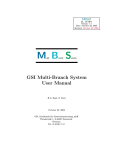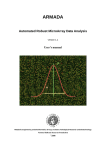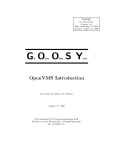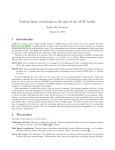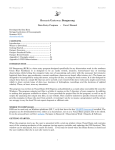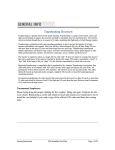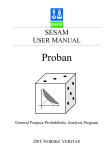Download MED Data Structure
Transcript
MED Data Structure
R. Lutter
May 20, 2005
Abstract
This document describes the structure of experimental data taken in MINIBALL experiments using the MARaBO
OU data acquisition system. MED is an abbreviation for ”MBS
Event Data” as this format is based on regular MBS data structures [1].
A detailed description of MBS data structures used as well as MARaBO
OU extensions to these
structures will be given.
1
Contents
1 MED file format
2
2 Event and subevent formats used by MARaBO
OU
2.1 Universal data storage: subevent formats [10,1] and [10,11] . . . .
2.2 Multi-module extension: subevent format [10,12] . . . . . . . . . .
2.3 XIA DGF-4C data: subevent formats [10,21], [10,22], and [10,23] .
2.4 Silena 4418V/T data: subevent formats [10,31] and [10,32] . . . . .
2.5 CAEN V7X5 data: subevent formats [10,41], [10,42], and [10,43] .
2.6 SIS 3XXX data: subevent formats [10,51], [10,52], and [10,53] . . .
2.7 Plain data containers: subevent formats [10,91], 10,92], and [10,93]
.
.
.
.
.
.
.
.
.
.
.
.
.
.
.
.
.
.
.
.
.
.
.
.
.
.
.
.
.
.
.
.
.
.
.
.
.
.
.
.
.
.
.
.
.
.
.
.
.
.
.
.
.
.
.
.
.
.
.
.
.
.
.
2
5
6
7
9
10
11
12
3 User Interface to MED data (C API)
3.1 Open a .med file . . . . . . . . . . . . . . . . . . . . . . . .
3.2 Read event by event and dispatch over event trigger . . . .
3.3 Decode subevent header . . . . . . . . . . . . . . . . . . . .
3.4 Extract subevent data, dispatch over subevent serial and/or
.
.
.
.
.
.
.
.
.
.
.
.
.
.
.
.
.
.
.
.
.
.
.
.
.
.
.
.
.
.
.
.
.
.
.
.
13
13
14
15
16
4 Appendix
4.1 C structure MBSDataIO . . . . . . . . . . . . . . . . . . . . . . . . . . . . . . . . .
17
17
1
. . .
. . .
. . .
type
.
.
.
.
1
MED file format
A .med file contains a stream of MBS events of standard type [10,1] (known as ”VME Event” inside
MBS). In contrast to the MBS file format (.lmd format) no buffering is used during output: data
are streamed out event by event by the generating program. As a consequence there is no event
spanning across buffer boundaries making things easier for the reader. Note that there is neither
a file header nor any buffer header, too. Each event contains a sequence of subevents all based on
MBS subevent [10,1] (so-called ”CAMAC Subevent”). There are several extensions to this subevent
type to cover different hardware and software requirements within MARaBOOU.
Fig. 1 shows the overall MED data structure, table 1 gives a list of subevent types used by MARaBOOU
applications [2].
Figure 1: Overall structure of MED data
2
Event and subevent formats used by MARaBO
OU
Fig. 2 shows standard MBS event and subevent headers as used in a MARaBOOU environment.
2
3
class name
TMrbSubevent_10_1
TMrbSubevent_10_11
TMrbSubevent_10_12
TMrbSubevent_DGF_1
TMrbSubevent_DGF_2 c
TMrbSubevent_DGF_3 c
TMrbSubevent_Silena_1
TMrbSubevent_Silena_2 c
TMrbSubevent_Caen_1
TMrbSubevent_Caen_2 c
TMrbSubevent_Caen_3 c
TMrbSubevent_Sis_1
TMrbSubevent_Sis_2 c
TMrbSubevent_Sis_3 c
TMrbSubevent_Data_S
TMrbSubevent_Data_I
TMrbSubevent_Data_F
Table 1: Subevent types used by MARaBOOU
format
zero-compressed, data preceeded by channel number
data w/o channel numbers, zero-padded
same as [10,1], including module headers
original XIA format
...
...
zero-compressed Silena format
...
original CAEN format
...
...
original SIS format
...
...
short (16 bit) data
int (32 bit) data
float (32 bit) data
time stamp
dead time
default
mps a
1 only
1 only / any
any
any
any
any
any
any
any
any
any
any
any
any
–
–
–
–
–
–
b
for XIA DGF-4C modules
...
...
for Silena 4418V/T modules
...
for CAEN V785/V775 modules
...
...
for SIS 3XXX modules
...
...
universal data container
...
...
ppc clock, in steps of 100 µs
contents of dead time scaler
default (empty) subevent
comment
universal MBS subevent
universal MARaBOOU subevent
b As
per subevent
there is no module id in this format the sequence of modules has to be known to the reader. To avoid ambiguities it is recommended to store 1 module per subevent only.
c Note: formats 2 and 3 have same data structure on input but follow different output strategies
a modules
[type,subtype]
[10,1]
[10,11]
[10,12]
[10,21]
[10,22]
[10,23]
[10,31]
[10,32]
[10,41]
[10,42]
[10,43]
[10,51]
[10,52]
[10,53]
[10,91]
[10,92]
[10,93]
[9000,1]
[9000,2]
[111,111]
Figure 2: Standard MBS headers used in MARaBOOU [1]
word count
subtype
type
trigger
event count
word count
subtype
type
crate
serial
event header
number of 16 bit words for this event a
event subtype (=1)
event type (=10)
trigger number
MBS event count
subevent header
number of 16 bit words for this subevent a
subevent subtype b
subevent type b
crate number (VME=0, CAMAC=1,2,...)
subevent serial number c
a excluding
first 2 header words, thus event/subevent length is (N=wc+4) 16 bit words
table 1
c assigned sequentially during Config.C step
b see
Note: Data have differently to be swapped on input depending on data type (8/16/32 bits)!
4
2.1
Universal data storage: subevent formats [10,1] and [10,11]
Subevent formats [10,1] and [10,11] are universal formats to store module data in a straightforward
way. Format [10,1] contains zero-compressed data preceeded by channel numbers; it is therefore
recommended for modules having a large number of channels, but only a few hits. Format [10,11]
contains one data item per channel, missing channels are padded with a zero data value. Thus this
format is more applicable to store module data where most of the channels have converted. As
there is no module identification inside these formats it is recommended to store only one module
per subevent. Data have to be aligned to 32 bit boundaries, so in case of an odd number of module
channels there is a filler (0xFFFF) at end of data.
Figure 3: Subevent formats [10,1] and [10,11]: universal storage
5
2.2
Multi-module extension: subevent format [10,12]
Subevent format [10,12] is an extension to format [10,1]: zero-compressed data preceeded by channel numbers are written together with a module header. Thus several modules may easily be stored
in one subevent.
Figure 4: Subevent format [10,12]: data zero-compressed, any number of modules
mid
mserial
wc
a assigned
module id
module serial number a
word count, including header words
sequentially during Config.C step
6
2.3
XIA DGF-4C data: subevent formats [10,21], [10,22], and [10,23]
Formats [10,2X] are used to store original buffers read from XIA DGF-4C modules [3].
Figure 5: Subevent format [10,2X]: DGF-4C buffer data
buffer
module
format
buffer
wc
number
descriptor
time
hit pattern
event time
a assigned
buffer header
number of 16 bit words in this buffer
module serial number a
data format used for channel data
48 bit buffer starting time
event header
one bit per active channel
32 bit event starting time
sequentially during Config.C step
7
Several list mode formats are available to control the DGF-4C data flow. Depending on the value
of the format descriptor in the buffer header (fig. 5) long or short channel headers with or without
trace data will be written. Fig. 6 shows different channel layouts. For a detailed description see [3].
Figure 6: Subevent format [10,2X]: DGF-4C list mode formats
word count
fast trigger time
energy
PSA value
GSLT time
realtime
trace data
channel header
number of 16 bit words written for this channel
time of arrival
converted energy value
result of pulse shape analysis (XIA and user)
48 bit arrival time of global second level trigger
time since last reboot or reset (high word: bits 47-32)
array containing trace data depending on format descriptor
8
2.4
Silena 4418V/T data: subevent formats [10,31] and [10,32]
Formats [10,31] and [10,32] are used to store zero-compressed data from Silena 4418V/T modules.
Several modules may be stored in one subevent. In case of uncompressed Silena data subevent
type [10,11] has to be used instead (one module per subevent only).
Figure 7: Subevent format [10,3X]: Silena 4418V/T data
wc
module number
pattern
data
a assigned
number of words (including header and pattern)
module number a
8 bit pattern word: active channels have bit=1
12 bit adc/tdc data
sequentially during Config.C step
9
2.5
CAEN V7X5 data: subevent formats [10,41], [10,42], and [10,43]
Formats [10,4X] provide containers for original CAEN list mode data produced by modules CAEN
V785 and CAEN V775, respectively. Each CAEN buffer may contain up to 32 events. In addition,
as each event is tagged with module number one may store data from several CAEN modules in
one subevent. To be able to correlate time stamps in DGF and CAEN branches in MINIBALL
experiments data have to be stored one module per subevent, however. A detailed description of
this format may be found in [4]
Figure 8: Subevent format [10,4X]: CAEN V7X5 ADC/TDC data
0x200
0x000
0x400
crate
wc
mserial
channel
data
event count
header word including word count and module number a
data word: channel number and converted dataa
trailer word: event counta
crate number b
number of channel data (32 bit, excluding header & trailer)
module serial number c
channel number (0 . . . 31)
12 bit adc/tdc data + 1 bit overflow + 1 bit underflow
number of events since last reset
a GEO
address not used
unused in MARaBO
OU
c assigned sequentially during Config.C step
b currently
10
2.6
SIS 3XXX data: subevent formats [10,51], [10,52], and [10,53]
Formats [10,5X] are designed to store data produced by SIS 3600 or SIS 3801 modules. This format
is identical to format [10,12].
Figure 9: Subevent format [10,5X]: SIS 3XXX data
mid
mserial
wc
a assigned
module id
module serial number a
word count, including header words
sequentially during Config.C step
Note: In current MINIBALL experiments data from SIS 3801 scalers will be written using format
[10,11] rather than this one.
11
2.7
Plain data containers: subevent formats [10,91], 10,92], and [10,93]
Formats [10,9X] provide containers to store data that are not directly related to a hardware module
(e.g. internal DGF scalers). There are containers for short [10,91], long [10,92], and float items
[10,93], respectively.
Figure 10: Subevent format [10,9X]: Plain data containers
12
3
User Interface to MED data (C API)
This section describes the C user interface which may be used to access MED data without running
ROOT. It includes function calls to
• open med files
• read event by event and dispatch over event trigger
• decode subevent header
• extract subevent data and dispatch over subevent type and/or serial number
Any prototype for this user interface is defined in file mbsio.h. So you have to include this file in
front of your code:
#include <stdio.h>
#include "mbsio.h"
To include this package in a C++ environment, add prototype definitions from file mbsio_protos.h:
#include "mbsio_protos.h"
3.1
Open a .med file
MBSDataIO * mbs_open_file(const char * FileName, const char * Connect,
int BufSize, FILE * HdrOut);
int mbs_close_file(MBSDataIO * MbsHandle);
const char * FileName
const char * Connect
int BufSize
FILE * HdrOut
MBSDataIO * MbsHandle
file name, extension has to be .med
how to connect to med data stream, has to be F (”File”)
buffer size, normally 0x4000 (16k)
where to output header info, set to NULL for ”no output”
file handle to access med data
mbs open file opens a med raw data file for reading and returns a file handle to refer to it.
mbs close file closes the file pointed to by the file handle.
Example:
MBSDataIO * mbsHandle;
mbsHandle = mbs_open_file("run123.med", "F", 0x4000, NULL);
if (mbsHandle = NULL) { printf("Error\n"); exit(1); }
13
3.2
Read event by event and dispatch over event trigger
unsigned int mbs_next_event(MBSDataIO * MbsHandle);
int mbs_get_event_trigger(MBSDataIO * MbsHandle);
MBSDataIO * MbsHandle
file handle as returned by mbs_open_file
mbs next event moves on to next event, adjusts internal pointers. Returns event type [subtype,type]
which is always [1,10]. User has to check for special return values MBS_ETYPE_EOF (end of file),
MBS_ETYPE_ERROR (error), and MBS_ETYPE_ABORT (abort).
mbs get event trigger returns trigger number of current event.
Example:
unsigned int evtType;
int evtTrigger;
while (1) {
evtType = mbs_next_event(mbsHandle);
if (evtType == MBS_ETYPE_EOF) {
printf("End of file\n");
mbs_close_file(mbsHandle);
} else if (evtType == MBS_ETYPE_ERROR) {
printf("Illegal event - skipped\n");
continue;
} else if (evtType == MBS_ETYPE_ABORT) {
printf("Illegal event - aborting\n");
break;
} else {
evtTrigger = mbs_get_event_trigger(mbsHandle);
switch (evtTrigger) {
case kMrbTriggerStartAcquisition:
printf("Trigger \"start acquisition\"\n");
break;
case kMrbTriggerStopAcquisition:
printf("Trigger \"stop acquisition\"\n");
break;
case kMrbTriggerReadout:
process_event(mbsHandle, evtTrigger);
break;
case .....
break;
default:
printf("Illegal trigger %d\n", evtTrigger);
break;
}
}
}
14
3.3
Decode subevent header
unsigned int mbs_next_sheader(MBSDataIO * MbsHandle);
unsigned int mbs_get_sevent_subtype(MBSDataIO * MbsHandle);
int mbs_get_sevent_serial(MBSDataIO * MbsHandle);
MBSDataIO * MbsHandle
file handle as returned by mbs_open_file
mbs next sheader moves on to next subevent of current event. Decodes header information and
returns subevent type [subtype,type]. User has to check for special return values MBS_STYPE_EOE
(end of event), MBS_STYPE_ERROR (error), and MBS_STYPE_ABORT (abort).
mbs get sevent subtype returns subtype portion of subevent type (LH word of [subtype,type],
right-shifted).
mbs get sevent serial returns serial number of current subevent.
Subevent type and/or serial number may then be used to dispatch to different decoding routines.
Example:
void process_event(MBSDataIO * mbsHandle, int evtTrigger) {
unsigned int sevtType;
int sevtSerial;
while (1) {
sevtType = mbs_next_sheader(mbsHandle);
if (sevtType == MBS_STYPE_EOE) {
return;
} else if (sevtType == MBS_STYPE_ERROR) {
printf("Illegal subevent - skipped\n");
continue;
} else if (sevtType == MBS_STYPE_ABORT) {
printf("Illegal subevent - aborting\n");
break;
} else {
sevtSerial = mbs_get_sevent_serial(mbsHandle);
process_subevent(mbsHandle, sevtSerial);
}
}
}
15
3.4
Extract subevent data, dispatch over subevent serial and/or type
unsigned int mbs_next_sdata(MBSDataIO * MbsHandle);
int mbs_get_sevent_wc(MBSDataIO * MbsHandle);
unsigned short * mbs_get_sevent_dataptr(MBSDataIO * MbsHandle);
MBSDataIO * MbsHandle
file handle as returned by mbs_open_file
mbs next sdata moves on to data section of current subevent, adjusts pointers. Returns subevent
type [subtype,type]. User has to check for special return values MBS_STYPE_ERROR (error) and
MBS_STYPE_ABORT (abort).
mbs get sevent wc returns word count of current subevent (16 bit words).
mbs get sevent dataptr returns pointer to first data word.
Example:
void process_subevent(MBSDataIO * mbsHandle, int sevtSerial) {
unsigned int sevtType;
unsigned short * dataPtr;
int wc, clusterNo, caenNo;
sevtType = mbs_next_sdata(mbsHandle);
if (sevtType == MBS_STYPE_ERROR) {
printf("Illegal subevent - skipped\n");
return;
} else if (sevtType == MBS_STYPE_ABORT) {
printf("Illegal subevent - aborting\n");
exit(1);
} else {
wc = mbs_get_sevent_wc(mbsHandle);
dataPtr = mbs_get_sevent_dataptr(mbsHandle);
switch (sevtType) {
case MBS_STYPE_CAMAC_DGF_3:
clusterNo = sevtSerial - kMrbSevtClu1 + 1;
process_dgf_data(clusterNo, dataPtr, wc);
break;
case MBS_STYPE_VME_CAEN_3:
caenNo = sevtSerial - kMrbSevtCaen1 + 1;
process_caen_data(caenNo, dataPtr, wc);
break;
case .....
}
}
}
User should refer to mbsio.h for possible subevent types MBS_STYPE_<XXX> and to DgfCommonIndices.h
for valid serial numbers kMrbSevt<xxx> defined for his experiment.
16
4
4.1
Appendix
C structure MBSDataIO
C structure MBSDataIO holds all information needed to describe an open connection to a .med data
file. In addition to the methods described so far user may access all of its elements by addressing
mbsHandle->element_name
A description of all data members of structure MBSDataIO:
char id[16];
FILE *input;
int fileno;
char device[MBS_L_STR];
char host[MBS_L_STR];
unsigned int connection;
MBSBufferElem *buftype;
int byte_order;
MBSShowElem show_elems[MBS_N_BELEMS];
int bufsiz;
MBSServerInfo *server_info;
int max_streams;
int slow_down;
int nof_streams;
int nof_buffers;
int nof_events;
int cur_bufno;
int cur_bufno_stream;
int bufno_mbs;
int buf_to_be_dumped;
char *hdr_data;
MBSBufferPool buf_pool[MBS_N_BUFFERS];
MBSBufferPool * poolpt;
char *bufpt;
int buf_valid;
int buf_oo_phase;
MBSBufferElem *evttype;
int evtsiz;
char *evtpt;
int evtno;
int evtno_mbs;
char *evt_data;
MBSBufferElem *sevttype;
int sevtsiz;
char *sevtpt;
int sevtno;
int nof_sevents;
int sevt_id;
unsigned int sevt_otype;
int sevt_minwc;
int sevt_wc;
char *sevt_data;
internal struct id: %MBS_RAW_DATA%
input stream descr (fopen/fread)
channel number (open/read)
name of input dev
host name
device type, MBS_DTYPE_xxxx
buffer type
byte ordering
buffer elements to be shown automatically
buffer size
info block for server access
max number of streams to process
number of secs to wait after each stream
number of streams processed so far
number of buffers
number of events
buffer number
... within current stream
buffer number as given by MBS
if n>0 every nth buffer will be dumped
file header data
buffer pool
... pointer to current buffer in pool
pointer to current data
TRUE if buffer data valid
buffer out of phase
event type
event size (bytes)
ptr to current event in buffer
current event number within buffer
event number as given by MBS
copy of event data (original, byte-swapped if necessary)
subevent type
subevent size (bytes)
ptr to original subevent in evt_data
current subevent number within event
number of subevents
current subevent id
original subevent type [subtype,type]
min number of data words expected
number of data words
ptr to subevent data (unpacked)
17
References
[1] H. Essel et al.: GOOSY Buffer Structure.
See http://wwwgsivms.gsi.de/goodoc/GM BUFFER.ps
[2] R. Lutter, O. Schaile et al.:
MARaBOOU - MBS and ROOT Based Online/Offline Utility.
See http://www.bl.physik.unimuenchen.de/marabou/html
[3] X-Ray Instrumentation Associates: DGF-4C User’s Manual, DGF-4C Programmer’s Manual
[4] CAEN S.p.A: V785/V775 Technical Information Manual.
See http://www.caen.it/nuclear/product.php?mod=V785
18



















